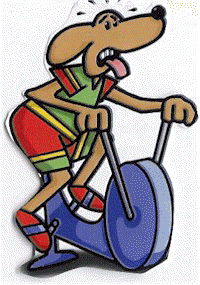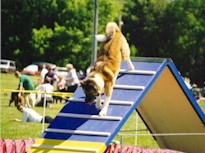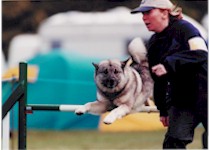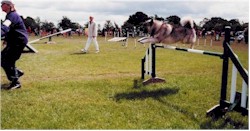| |
>>>Slow
and steady doesn't
win
the race>>>>>
 Several
years ago Leona Hellesvig and her Cocker Spaniel Ember took a class which was specifically for
dogs who had been in agility for a few years but were too slow to make the course time. It was
run by trainers Martha Healy, Carol Smorch, Dan Dege and a few other guest instructors, and
it lasted for an entire winter which can be a long cold time in Minnesota! The course was
called 'Go Crazy, Go Nuts' and it really helped! Several
years ago Leona Hellesvig and her Cocker Spaniel Ember took a class which was specifically for
dogs who had been in agility for a few years but were too slow to make the course time. It was
run by trainers Martha Healy, Carol Smorch, Dan Dege and a few other guest instructors, and
it lasted for an entire winter which can be a long cold time in Minnesota! The course was
called 'Go Crazy, Go Nuts' and it really helped!
What I learned is that every dog does not respond to the
same things, and the fix for the problem will not happen in two weeks. A commitment needs to be
made for a longer period time, say six months or so, and that during the re-training period, it
is better to not do trials and reinforce the old habits.
Some of the things that worked for various individuals:-
1) Build separation anxiety.
Put the dog in the kennel at ringside after doing a warm-up, and run them right out of
the kennel. Alternatively give the dog to someone else to hold and go completely out of sight
for a period of time - maybe ten minutes or more. Then for some dogs but not others, stand
within their sight but out of their reach, and play with another dog. Ignoring the dog worked,
too. This was effective for about one out of three of the dogs, Ember included.
2) Never, well almost never lead out
from the start and the table.
The exception would be if there is a major
handling trap or turn out there that really must be handled that way.
3) Practice lots of restrained recalls
and races over obstacles to a prize.
Do not hold the collar. The collar-hold actually
slows some dogs down rather than speeds them up! Instead, have hold lightly by the flanks/front
of the thighs. Start with just a race with your dog to the table to get a treat. You get a
lead-out start of a couple of steps, and you need might need an assistant to guard the treat
just in case it isn't earned. Then try doing jump/table, or tunnel, table, etc. Eventually, you
can try other obstacle combinations too. You are also re-training for the day you can add the
'lead out from the start' back into your bag of tricks again. But even at that, use that
lead-out sparingly.
4) Give up the 'stop and wait'
on contacts for slow dogs.
Re-train for just running down through the
contact zone. Slow dogs will almost never blow the contact IF you signal to the ground at the
end of the contact, and YOUR EYES focus down there until you see the dog hit the yellow with
your peripheral vision. The biggest trick to this is not lifting your eyes or hand too soon. If
you look up to find the next obstacle, or flinch, the dog may jump the contact if they are
responsive at all.
5) Try running the outside of
the curve on the tunnel.
Make noises like actually rubbing your
hand on the tunnel - in training only - until your dog gets so fast that you can no longer beat
them around the tunnel. Be sure not to touch the tunnel in competition
 6)
Always do cross in fronts almost always. 6)
Always do cross in fronts almost always.
Use a blind cross or cross in front for
turns at jumps, and never do a cross behind for ANY reason, ever! These cross in fronts are
especially useful at tunnels! They are like magic to speed up your dog. Those blind crosses
take lots of practice, but they actually work for slow dogs better than cross behinds, and are
better than cross in fronts when the dog improves a little, but if the dog is still in that
medium-speed zone.
7) Re-train the see-saw from
ground zero
If the see-saw is a problem -it was for
Ember and me, too - you will need to completely re-train it from ground zero. If you have an
adjustable teeter, put it as low as possible, only an inch or so, if you can. If that is not an
option, try putting two pause tables, one under each end, so that the tip is very little. Build
this one gradually. Do insanely crazy things like race to the end, and sit on the floor
cheering wildly, or pretending to eat his favorite treat. Try people food like cheese
or
carrots instead of plain old boring dog treats.
8) Work on speedy weaves
Use wires or channels to get a true run through
them rather than just a trot.
9) Do puppy push ups on a regular
basis
Train sit, down, sit, down, sit, down, treat,
sit, down, treat sit, down, sit, down, sit, down, etc. to improve table speed for drops and
sits.
 10)
Never, ever run the course faster than your dog. 10)
Never, ever run the course faster than your dog.
In other words, do not get ahead of the
dog. I was amazed by the fact that almost every dog that was slow to start with would get
slower if the handler got ahead of the dog. It doesn't always make sense, but it is true.
These things take time. Not every strategy will work for
every dog. You have to find out which ones work for your dog by trying them. Actually, there
were other things that were tried too, but I don't remember them all!
For me, the biggest part of our recovery came with
re-teaching the teeter for the fourth time at least! and with learning to use better handling
strategies. I discovered that most of the problems we were having, including the
stress-sniffing, and the mad idiot running around the ring when the frustration got bad enough,
would come if the dog was unsure or confused by my handling.
How I handled things had a very major impact on the speed
I could get out of my dog on any given run. How I handled gave the dog confidence, or confusion
in any course situation, and, on any given day, once we were slow for the first run, it
sometimes carried on for the rest of the day. So, work hardest on handling!
Keep on working on it. It can be done. I did it, and so
did nearly everyone in that class. You can, too!
About the author
Leona Hellesvig, now in her mid-40s,
has been exposed to dog shows and dog training all her life. Her mother bred American
Cocker Spaniels, English Toy Spaniels (King Charles Spaniels in England -NOT the Cavaliers
-and
Australian Shepherds (pre-AKC acceptance).
She has shown in Conformation, and J+Junior Showmanship
classes from about the age of five and Obedience trials since she was about ten years old. In
all, she has trained some 20 dogs in Obedience in all three of those breeds, and finished
several Obedience titles.
Leona's interest in agility began with a seminar,
featuring Sharon Anderson as speaker, held by the local Cocker club in approximately 1987. In
1990, she began teaching agility to Dakota County (Minnesota, USA) 4-H kids. Those beginning
years were quite bumpy. It wasn't until about three years later that she actually gained a
first-hand knowledge of the sport by training her own dog.
Since then, she has trained two Cocker Spaniels in
agility who have taught her so much more about the sport than she ever would have learned by
training an 'easy' breed. Through many trials and tribulations, she has learned many lessons
the hard way, but says that sometimes those are the ones learned best. She is quite grateful to
them.
Many great teachers have helped me along the way, most of
whom are not nationally known names. Martha Healy, Debbie Brink, Becky O'Sell, Kathy Eckert,
and Ruth Van Kueren come to mind immediately.
Leona still teaches classes to 4-H kids every summer, and
is active as a 4-H project leader and dog judge at the county, regional, and state level in
Minnesota and Wisconsin. She lives in Minneapolis, Minnesota, USA.
Article © Leona Hellesvig
Thank you to David and Debbie Deuchar for giving permission to
use the photos of Harmar who was a slow dog but is no longer!
Photo: Action Shots.
| |
|